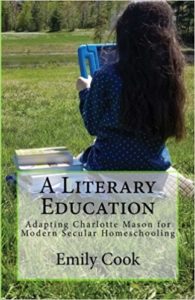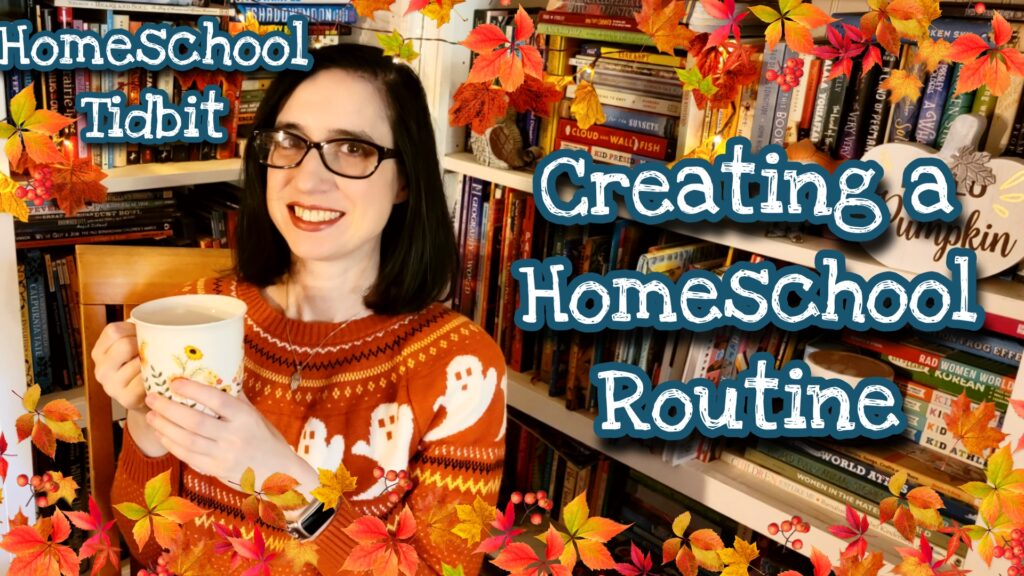Homeschool Tidbits: Creating a Routine
October 21, 2022
Welcome to Build Your Library’s Homeschool Tidbits: Episode 33 – Creating Routine. In this weekly video series, I will delve briefly into a topic related to homeschooling and will share some of my knowledge and expertise as a long-time homeschooling mother of 4 children. Three of whom have graduated high school and one who is a college graduate!
Homeschooling can feel so freeing! We aren’t tied to a schedule set by the public school system. Want to go on vacation in the middle of September? You can! Want to take a break from lessons and have a movie marathon next week? Go for it! But there can also be a downside to all that freedom.
Do you find that your day goes off the rails frequently? Are you always overwhelmed? Do you find it difficult to cover all the material you want to each day? If you answered yes to any of these questions, then this week’s tidbit is for you. What you are lacking is a set routine.
Now first, I want to explain that a “routine” is NOT a schedule. A schedule is strict, and it doesn’t allow for easy adjustments. Whereas a routine is more fluid and easier to follow. Routines are simply there to guide you. But they also allow you to handle things like doctors’ appointments, emergency trips to the vet, or occasionally oversleeping – without your whole day falling apart.
The Homeschool Routine
When you think of a homeschool routine, you want to remember that your life is more than just homeschooling. Make room in your day for things like meals, cooking, self-care, cleaning, and anything else you think is important. When you make room in your day for these things, I find that homeschooling goes smoother, because you know you are going to get both math AND laundry done in a day.
Also, this method works with any homeschooling style, whether you are a Charlotte Mason purist, eclectic, or school-at-home. Think of your routine as a daily rhythm. It’s the way your day naturally flows. With a routine, you move from task to task. There are no set time frames in which each task must be finished. If you plan to cover math in the morning, but your lesson takes longer than anticipated, you just move to the next task without feeling like your day is now behind. This means you can relax more and let your children learn at their own pace.
The Tasks
The first thing you want to do is think about the things you HAVE to do each day. These are your non-negotiables, such as math lessons, laundry, loading and unloading the dishwasher, cooking meals, and reading. Then think about things that might happen only a few times a week. Maybe that’s history lessons, science experiments, co-op, mopping and vacuuming floors, and grocery shopping.
Once you have those lists, you can start planning your routine. Divide up your day into segments:
- Early Morning
- Mid-Morning
- Late Morning
- Afternoon
- Late Afternoon
- Evening
- Bedtime
Those timeframes might look different for each person. My early morning is at 8 am, but yours might be at 6 am. This is why routines make more sense than schedules. If you oversleep and your day starts later, it’s still technically early morning when you first wake up. So your actual routine won’t change.
Take your lists and put your day together like a puzzle. Think about how your day tends to go when you are feeling your best. If you have subjects that you feel like you aren’t getting to frequently enough, make them happen first. There are no rules about what order you have to do your lessons. So if science seems to fall off the schedule frequently, bump it to the first or second thing you do in the morning.
Think about what things you can peg together. For example, you are already going to be eating breakfast together. So why not read some poetry together or listen to music over breakfast? Maybe you can peg your read-aloud time to lunch or to bedtime. Those are things that will definitely happen every day, so tag the things you want to include in your routine!
Sample Routine
As an example, a sample routine might look like this:
- Early Morning – Get up and dressed, wake children, unload dishwasher, make and eat breakfast, and music.
- Mid-Morning – Morning Basket time, Math, language arts, start laundry and load the dishwasher.
- Late Morning – History/Science lessons.
- Afternoon – Lunch and read aloud.
- Late Afternoon – Independent school work or free time, tidy up workspaces, load dishwasher (this could also be where you run errands, schedule dr. appointments, etc.).
- Evening – Cook and eat dinner, family time, or activities (like dance or karate).
- Bedtime – Read aloud, bath time, self-care, load and run the dishwasher.
Now that you have your routine planned out on paper, live it for a week or two. You will inevitably find you need to adjust. We always have bigger plans on paper than in reality. Just move things around as needed until you find that your day flows naturally from task to task. If you have older children, remember to delegate some of the chores to them! If you are struggling to get the floor swept or laundry folded, they can pitch in. Even an 8-year-old can learn to fold laundry or empty the trash. It might not be done perfectly, but it will be done.
Having a set routine gives true flexibility in your homeschool. It ensures that you get to the most important things when they make the most sense for you and your family. It means that when you have to fit in doctors’ appointments or field trips you can still fit in the rest of your routine around those events. Having a homeschool routine in place means that when things are out-of-whack, whether it is a crisis or just a sick day you can still hold your day together because you and your children know what comes next.
Coming up next…
I hope you found this Tidbit helpful! Come back next week for more homeschooling inspiration!
Until then, happy reading!
See Other Related Articles:
- Happy, Hygge Homeschooling?
- “Are worms made out of metal?” And other great rabbit trails.
- Charlotte Mason in the Secular Homeschool
- A Literary Education book
- About Build Your Library
- Homeschool Tidbits: Build Your Library’s Weekly Video Blog Series
.
 Emily Cook is the author and creator of the secular homeschool curriculum Build Your Library, a literature-based K-12 program infused with the teachings of Charlotte Mason. She writes full-year lesson plans as well as shorter topical unit studies. Emily has been homeschooling her four children in Southern NH for 21 years. She is passionate about reading aloud to children of all ages and loves to share her love of literature with others. She and her family also make incredibly dorky videos about homeschooling, books, and more on Youtube at ARRRGH! Schooling. You can follow her on Facebook, Twitter, and Pinterest. You can also check out her author page on Amazon.
Emily Cook is the author and creator of the secular homeschool curriculum Build Your Library, a literature-based K-12 program infused with the teachings of Charlotte Mason. She writes full-year lesson plans as well as shorter topical unit studies. Emily has been homeschooling her four children in Southern NH for 21 years. She is passionate about reading aloud to children of all ages and loves to share her love of literature with others. She and her family also make incredibly dorky videos about homeschooling, books, and more on Youtube at ARRRGH! Schooling. You can follow her on Facebook, Twitter, and Pinterest. You can also check out her author page on Amazon.

